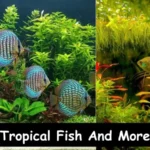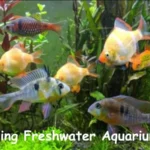fish diversity
Fish That Start With O
The underwater world is a vast and diverse realm, teeming with creatures of all shapes, sizes, and colors. Among this incredible array of aquatic life, there are many fish that start with O. From the familiar to the exotic, these “O” fish offer a glimpse into the fascinating diversity of life beneath the waves. In today’s article, let’s learn more about this issue with fishtankmagic.com!
Fish That Start With O
Ocean Sunfish (Mola mola)
The Ocean Sunfish, also known as the Mola mola, is a truly remarkable creature. It holds the title of the heaviest bony fish in the world, with adults typically weighing between 1,000 and 2,000 pounds. Its appearance is equally striking, with a flattened, disc-shaped body and a small, pointed mouth. The Ocean Sunfish is a pelagic species, meaning it lives in the open ocean, and it can be found in warm waters around the globe. While its diet consists primarily of jellyfish, it also consumes small fish, plankton, and squid.
The Ocean Sunfish is a fascinating example of how evolution can produce truly unique and awe-inspiring creatures. Its massive size, unusual shape, and pelagic lifestyle make it a standout among the fish kingdom. While its exact purpose in the marine ecosystem is still being studied, it is clear that the Ocean Sunfish plays a vital role in maintaining the balance of life in the ocean.
Ocellaris Clownfish (Amphiprion ocellaris)
The Ocellaris Clownfish, also known as the Percula Clownfish, is a popular aquarium fish due to its vibrant orange and white coloration and its symbiotic relationship with sea anemones. These small fish, typically reaching a maximum length of 4 inches, are found in the coral reefs of the Indo-Pacific region. They are known for their aggressive territorial behavior, particularly towards other clownfish species.
The Ocellaris Clownfish’s symbiotic relationship with sea anemones is a fascinating example of mutualism in nature. The clownfish gains protection from predators by living within the stinging tentacles of the anemone, while the anemone benefits from the clownfish’s waste, which provides nutrients. The clownfish is also known to clean the anemone of parasites, further strengthening their symbiotic bond.
Orange Roughy (Hoplostethus atlanticus)
The Orange Roughy is a deep-sea fish that is found in the cold, dark waters of the Atlantic, Indian, and Pacific Oceans. It is known for its distinctive orange coloration, its rough, scaly skin, and its long lifespan, which can reach up to 150 years. While its slow growth rate and late maturity make it vulnerable to overfishing, the Orange Roughy is a valuable commercial species, prized for its firm, white flesh.
The Orange Roughy’s deep-sea habitat presents unique challenges for survival. The lack of sunlight and the extreme pressure require adaptations that allow these fish to thrive in such harsh conditions. Their slow growth rate and late maturity are likely adaptations to their slow-paced, deep-sea environment. However, these same adaptations make them particularly vulnerable to overfishing, highlighting the importance of sustainable fishing practices.
Ornate Wrasse (Halichoeres ornatus)
The Ornate Wrasse is a colorful and striking fish that is found in the tropical waters of the Indo-Pacific region. It is known for its distinctive orange and blue coloration, its long, slender body, and its unique behavior. The Ornate Wrasse is a protandrous hermaphrodite, meaning it begins life as a male and can later transition into a female.
The Ornate Wrasse’s transition from male to female is a fascinating example of sexual plasticity in the animal kingdom. This process is triggered by social cues, with the largest and most dominant male in a group becoming the female. The Ornate Wrasse’s unique reproductive strategy is likely an adaptation to its social structure and the challenges of finding mates in a coral reef environment.
Other Fish That Start With O
While the above examples represent some of the most well-known “O” fish, there are many other fascinating species that deserve mention. These include:
- Ogilby’s Pipefish (Corythoichthys ogilbyi): A small, slender fish with a long, tubular snout that resembles a pipe. It is found in the tropical waters of the Indo-Pacific region.
- Ocellated Butterflyfish (Chaetodon ocellatus): A colorful and striking fish with a distinctive black spot on its dorsal fin. It is found in the tropical waters of the Indo-Pacific region.
- Opah (Lampris guttatus): A large, deep-sea fish with a distinctive red coloration and a round, disc-shaped body. It is found in the temperate waters of the Atlantic, Indian, and Pacific Oceans.
- Orange-spotted Grouper (Epinephelus guttatus): A large, predatory fish with a distinctive orange coloration and black spots. It is found in the tropical waters of the Atlantic Ocean.
- Ocellated Triggerfish (Rhinecanthus aculeatus): A colorful and aggressive fish with a distinctive black spot on its dorsal fin. It is found in the tropical waters of the Indo-Pacific region.
Conclusion
The diversity of fish that start with “O” is a testament to the incredible richness and complexity of the underwater world. From the massive Ocean Sunfish to the colorful Ornate Wrasse, these “O” fish offer a glimpse into the fascinating adaptations and behaviors that have allowed life to thrive in the depths of the ocean. As we continue to explore the marine environment, we are sure to discover even more “O” fish, each with its own unique story to tell.
The letter “O” may be just a single letter, but it represents a vast array of fascinating and diverse fish species that contribute to the vibrant tapestry of life in the ocean. By studying these “O” fish, we gain a deeper understanding of the intricate relationships between organisms and their environment, and we are reminded of the importance of protecting this precious and irreplaceable ecosystem.












